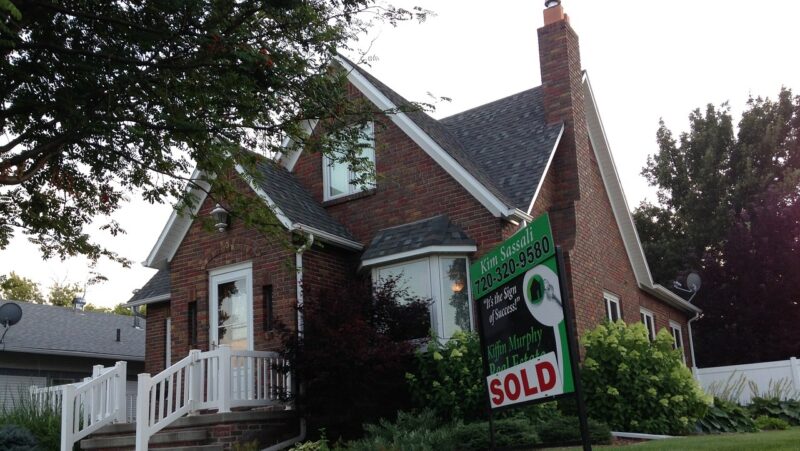We talk a lot about how the Fed keeps its big fat thumb on the Treasury market. But it also has its big fat thumb on the housing market. And if the Fed really does follow through with its taper and its plans to shrink its balance sheet, it will have a big effect on the housing market.
This article was originally published by SchiffGold.
If you’ve ever held something under tension down with your thumb and suddenly release it, you know what happens.
Pop!
As of October 2021, housing prices had skyrocketed over 18% year-on-year. Housing prices are far above their 2006 bubble peak, even adjusting for inflation.
The Fed has helped inflate this housing bubble by buying mortgage-backed securities. This allows lenders to take mortgages off their books and make then make new loans. In the same way, quantitative easing creates artificial demand for Treasuries, thereby keeping rates low and facilitating more federal government borrowing and spending, it also keeps mortgage rates artificially low and juices the housing market.
As economist Alex Pollock put it in an article published by the Mises Wire, the Fed “continues to be the price-setting marginal buyer or Big Bid in the mortgage market, expanding its mortgage portfolio with one hand, and printing money with the other.”
In 2006, the Fed owned zero mortgages. Today, The central bank holds about $2.6 trillion in mortgage-backed securities on its balance sheet. According to Pollock, about 24% of all outstanding residential mortgages in the US reside in the central bank. That makes the Fed, by far, the largest savings and loan institution in the world.
We have been saying that the Fed can’t do what it’s saying it will do to fight inflation, and this is yet another reason. If it stops buying mortgage-backed securities and then starts selling them into the market, mortgage rates are going to skyrocket. The housing bubble will pop. Again.
The Fed started buying mortgages in the wake of the 2006 housing crisis. It was supposed to be a temporary emergency measure. The problem with a lot of temporary emergency measures is that they become permanent. The Fed never did shrink its mortgage-backed security holding to zero after the housing crisis. And when the coronavirus crisis hit, the Fed doubled down. This raises an important question. Pollock puts it this way: “An abiding problem is how you can reverse central bank and government crisis interventions, initially thought and meant to be temporary, after the crisis passes.”
The idea that government intervention, required in times of crisis, should be withdrawn in the renewed normal times which follow, I call the Cincinnatian Doctrine. It is named for the ancient Roman hero Cincinnatus, who was called from his plow to save the State, became temporary Dictator, did save the State, and then, mission accomplished, went back to his farm. (I introduced this term at the IUHF World Congress in 2006, just before the housing bubble of the time imploded.)
However sincere the intent that they should be temporary, the emergency interventions inevitably build up economic and political constituencies who profit from them and want them continued indefinitely. The difficulty of winding them back down, once they have become established, I call the Cincinnatian Problem. There is no easy answer to the problem. How, so to speak, do you get the Federal Reserve to go back to its farm, once it has enjoyed becoming the dominant mortgage investor in the world?
Interestingly, the Fed resisted pressure to wade into the housing market in the 1960s. Congress wanted the central bank to buy debt from Fannie Mae and other federal agencies involved with housing. Then-Fed Chairman William McChesney Martin testified that the practice would “violate a fundamental principle of sound monetary policy in that it would attempt to use the credit-creating powers of the central bank to subsidize programs benefitting special sectors of the economy.”
But in 2006, the politicians got what they needed – a crisis. Principles were tossed in the waste bin and the Fed used its “credit-creating powers” to subsidize housing and finance.
Pollock again raises the key question.
When the crises are over, and the interventions have become huge distortions, what next? Can we now even imagine a Federal Reserve which owns zero mortgages? At this point, can the Federal Reserve itself imagine that?”
We know this — if the Fed does start unwinding its “emergency” measures, it will have a profound impact on the housing market. Just how profound remains to be seen. Pollock asks a few more important questions you should consider as the Fed contemplates monetary tightening.
If the Federal Reserve stops being the Big Bid for mortgages, how much higher will mortgage interest rates go from their present abnormally low level? When the mortgage rates rise, how quickly will the house price inflation end? Will it reverse? How will the Federal Reserve, and the country, address their Cincinnatian Problem?”
Everybody anticipates the Fed tightening substantially to fight inflation. But nobody seems to be considering the possible consequences. We’ve said it’s a heads you lose, tails you lose scenario. If the Fed doesn’t deal with inflation, it could ultimately collapse the dollar. But dealing with inflation could collapse the housing market — and the broader economy.





